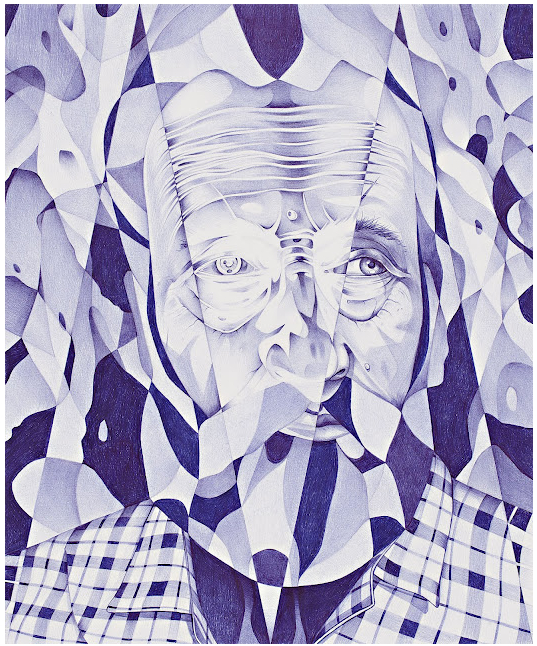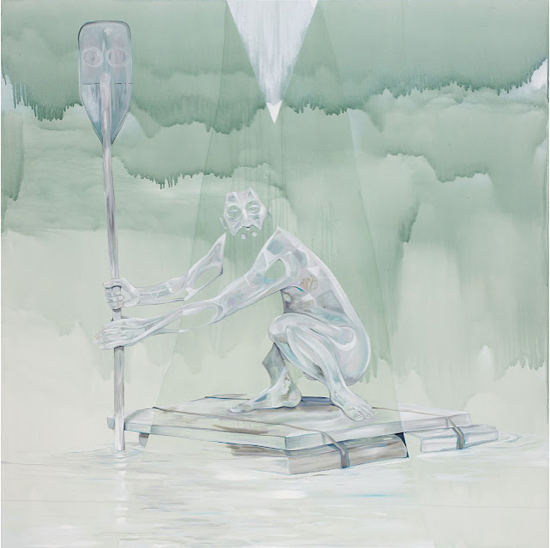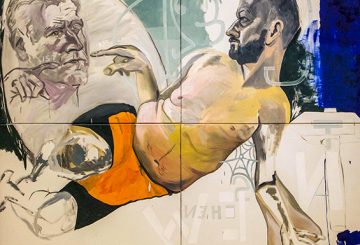Sharne Wolff encounters the strange tale of Waterface in Laith McGregor’s latest solo show…
After a gallery hop around the inner south of Sydney on a hot Tuesday last week, I’d almost decided that what started off as a potential review might more likely be turned into a post entitled ‘How Not to Sell Art – 10 quick and easy steps’. Completely ignored during my visit to several galleries, Chris Hodges at Utopia Art finally came to the rescue with some friendly banter about his current show of abstract works. Aptly titled ’abstraction’ this show goes a long way to prove the point that Indigenous desert paintings can sit neatly alongside non-indigenous abstracts without either looking out of place.
Laith McGregor, Fairweatherer , 2012. Biro on paper, 40 x 33cm.
Reinvigorated after our chat and with the help of my artwhatson iphone App (and no, they didn’t pay me to say that) I wandered around to Sullivan and Strumpf to check out Laith McGregor’s new show ‘Ohne Titel (Them Listless Folk from Apocryphal)’. Although the exhibition is already on display its official opening has been timed to coincide with Art Month Bar on 15 March. I’d earlier stared at the title over a cup of coffee trying to figure out if it was an anagram. Not quite as it turns out. The Gallery staff informed me that ‘Ohne Titel’ is German for ‘Untitled’. So that means it’s an untitled show – with a curious subtitle. Compared to most of what I’d seen earlier in the day, McGregor’s latest output is certainly refreshing. But it’s not quite a ‘thunderbolt’– there is so much in this show that in order to absorb the number of works and broad practice of this artist you need to let it all sink in slowly. After a while I decided that it would almost be impossible for me not to write about it. Perhaps it would help me to make sense of what I’d seen.
McGregor has been prolific since his last solo show with Sullivan and Strumpf in 2011. There are 37 works on display here. The exhibition includes everything from McGregor’s characteristic biro drawings to sculpture, lots of small oil paintings, five very large oils on linen, a digital video and the piece de resistance …a ping pong table covered in a year’s worth of McGregor’s detailed drawings and musings and entitled ‘Pong Ping Paradise 2011’. On the day I visited, a couple of days after opening, almost all works had been sold with the exception of the glass covered table which (I guess) is a little hard to house without it being overly tempting to use. It also raises questions about art and function especially after some would-be purchasers (an advertising company) apparently planned to display it in their entrance foyer. The staff and I spoke about it while we stood in the upstairs gallery. Did the artist intend the table be used to play ping pong? Should art have a function? A ping pong table is not a fur-covered cup and saucer] after all.
Laith McGregor, In the Future, 2012. Oil on linen 168.5 x 168.5cm.
A strong presence in this show is the artist’s imaginary childhood friend ‘Waterface’ who has appeared throughout McGregor’s past practice. (As an aside I wonder if helicopter parenting has reduced the presence of imaginary friends in the new millennium but decide that’s probably best left to an article for ‘Sydney’s Child’ or somewhere similar). The digital video in the upstairs gallery shows the artist on one side of a split screen in ‘Mind’s Eye’ apparently hypnotised in an effort to conjure up McGregor’s elusive friend for closer scrutiny.
In the same room are also a number of the artist’s familiar biro drawings – although this time, rather than use his family or appropriated images as in previous shows, McGregor has drawn portraits of Australian artist Ian Fairweather. Three pictures entitled ‘Fairweathered’, ‘Fairweather’ and ‘Fairweatherer’ are part of a series of 5, which also include ‘End Erased’ and ‘End End’ – both titles more pertinent when closely observed. ‘End Erased’ is in fact a drawing erased and framed with the pieces of rubbed-out paper. ‘End End’ includes the ball bearings from the biro within the frame. As for the Fairweather works, the portraits are abstract and the colours limited to the blue biro and white of the paper support. Although they are reminiscent of the Cubist style and curved patterns and sharp angles deconstruct the pictures, they don’t require significant decoding.
The downstairs gallery is awash with blue and green – the colours of water – and fantastical landscapes punctuated by figures, ghosts and floating circles composed of multicoloured triangles. I’m still wondering about McGregor’s interest in Fairweather, the hermetic artist who died in 1974, when I spy two of the major oils entitled ‘In the Future’ and ‘Drifter’. In the first, a ghostly near-naked man, forlorn and bearded, squats on a raft – his haunted paddle held in the air. In the second, painted a deep-sea green, the raft is there but the paddle replaced by a long stick and a spirit-like figure sits somewhere between the background and foreground. A shaft of light seems to come from above suggesting it may be moonlight. Are these references to Ian Fairweather’s famous Timor raft adventure? – I have no idea if this was the artist’s intention (especially given the title of the first) but I read somewhere that he’s a fan of those great adventure stories of the sea like ‘Robinson Crusoe’ and ‘Moby Dick’. A further clue is available from the painting of a shrouded figure entitled ‘Negro Marfil Island (after Wyeth) 2012’ painted after the American artist N.C. Wyeth’s work ‘Winter (1909)’ which was an original illustration for a book of poems. (N.C Wyeth, by the way, also illustrated many other books including ‘Treasure Island’ by Robert Louis Stevenson and was said to have appropriated some his own illustrations from other artists …but that’s a whole other story).
Two other paintings are of men (some ambiguously human) in boats. All these large oils are created with the application of thin veils of washed-over paint and lots of drips on the surface of the linen. Some of the smaller oils continue the theme of bearded hairy and hatted men of McGregor’s recent shows but the larger oils are more mysterious, especially in the detail. They illustrate magical scenes from the past and the future conjured, I presume, from McGregor’s imagination – although suggestions from art history and literature abound. Almost all McGregor’s figures are without eyes – their empty eye sockets sit in vacant faces that still manage to appear tragic (or perhaps listless?) extracting some empathy from the viewer. They might continue McGregor’s long examination of the masculine state or more simply the search for the identity of his friend ‘Waterface’. Shapes merge between foreground and background, between figure and water, between real and illusion. Plumes of smoke emanate from the mouths of men and rise in the air.
In this show McGregor has made visible his search for a bridge between the perceptible and the imagined. When I leave the gallery I feel like I’m walking away with numerous unanswered questions. One week later I probably have ten times more.
Laith McGregor
‘Ohne Titel (them Listless Folk from Apocryphal)’
Sullivan & Strumpf
Until 17 March.




“Completely ignored during my visit to several galleries…” And that’s in little ol’ provincial Sydney. In what is purported to be the big art smoke (NYC), it is de rigueur to ignore just about everywhere lest a gallery assistant or director be seen as somehow weak by showing the faintest trace of basic courtesy. Should you dare approach the impossibly high front desk (which is designed to hide said gallery assistant), I’m sure a silent alarm goes off the alerts the police to the possibility of an off-the-street intruder. However, I have always felt it my duty as an Australian not to play that game and try to engage even the most recalcitrant, stony faced attendant just to piss them off.
How not to sell art, indeed.
“Everywhere”? That should read “everyone”. Apologies.
Pingback: Laith McGregor’s latest Sydney exhibition ‘Ohne Titel (Them Listless Folk from Apocryphal)’ « Wolff.
Hi Sharne,
Not sure if you popped into our Gallery downstairs from Christopher Hodges, Utopia Art Sydney, but I am sincerely sorry if you had a negative experience. Despite being a commercial gallery, we endeavour to allow people a quiet, immersive experience and in fact very often leave people to their own devices until they indicate they’d like some further information or a chat about the work.
However it’s a fine line between being a ‘shop’ and a ‘gallery’ and I do hope we are never too caught up in our computers to at least acknowledge our visitors.